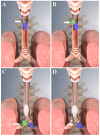A Randomized Controlled Trial Comparing Novel Triple-Cuffed Double-Lumen Endobronchial Tubes with Conventional Double-Lumen Endobronchial Tubes for Lung Isolation
- PMID: 32244659
- PMCID: PMC7230200
- DOI: 10.3390/jcm9040977
A Randomized Controlled Trial Comparing Novel Triple-Cuffed Double-Lumen Endobronchial Tubes with Conventional Double-Lumen Endobronchial Tubes for Lung Isolation
Abstract
Placing a double-lumen endobronchial tube (DLT) in an appropriate position to facilitate lung isolation is essential for thoracic procedures. The novel ANKOR DLT is a DLT developed with three cuffs with a newly added carinal cuff designed to prevent further advancement by being blocked by the carina when the cuff is inflated. In this prospective study, the direction and depth of initial placement of ANKOR DLT were compared with those of conventional DLT. Patients undergoing thoracic surgery (n = 190) with one-lung ventilation (OLV) were randomly allocated into either left-sided conventional DLT group (n = 95) or left-sided ANKOR DLT group (n = 95). The direction and depth of DLT position were compared via fiberoptic bronchoscopy (FOB) after endobronchial intubation between the groups. There was no significant difference in the number of right mainstem endobronchial intubations between the two groups (p = 0.468). The difference between the initial depth of DLT placement and the target depth confirmed by FOB was significantly lower in the ANKOR DLT group than in the conventional DLT group (1.8 ± 1.8 vs. 12.9 ± 9.7 mm; p < 0.001). In conclusion, the ANKOR DLT facilitated its initial positioning at the optimal depth compared to the conventional DLT.
Keywords: airway; double-lumen endobronchial tubes; fiberoptic bronchoscope; one-lung ventilation; thoracic surgery.
Conflict of interest statement
Young Jun Oh and Hyo-Jin Byon hold the intellectual property rights to the design of the ANKORTM double-lumen endobronchial tube, and they have licensed it to Insung Medical. Co. None of the other authors have any conflicts of interest.
Figures


References
-
- Campos J.H. Current techniques for perioperative lung isolation in adults. Anesthesiology. 2002;97:1295–1301. - PubMed
-
- Klein U., Karzai W., Bloos F., Wohlfarth M., Gottschall R., Fritz H., Gugel M., Seifert A. Role of fiberoptic bronchoscopy in conjunction with the use of double-lumen tubes for thoracic anesthesia: A prospective study. Anesthesiology. 1998;88:346–350. doi: 10.1097/00000542-199802000-00012. - DOI - PubMed
-
- Campos J.H., Hallam E.A., Van Natta T., Kernstine K.H. Devices for lung isolation used by anesthesiologists with limited thoracic experience: Comparison of double-lumen endotracheal tube, univent torque control blocker, and arndt wire-guided endobronchial blocker. Anesthesiology. 2006;104:261–266. doi: 10.1097/00000542-200602000-00010. - DOI - PubMed
LinkOut - more resources
Full Text Sources
Medical

